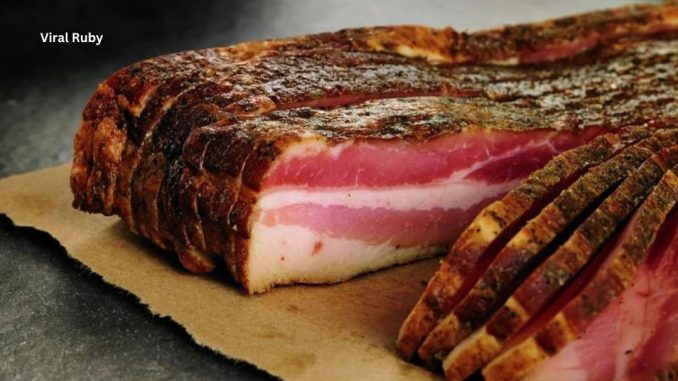
What Is Cured Meat Products VS Uncured?
Cured meat is a type of meat that has undergone a natural aging process. The process involves attracting salt molecules to the meat’s surface and evaporating them. Other methods of curing include exposure to sunlight and strong winds. These natural processes have been used for centuries by humans and are still used today. There are many different types of cured meat. However, only a few of them are commonly available worldwide.
What is cured meat?
Curing is a process that adds flavor and seasoning to meat. Common ingredients used in cured meat include salt, paprika, black pepper, and spices such as coriander and cumin. Other ingredients may be used to enhance flavor and speed up curing. Cured meat may be smoked or exposed to sunlight.
Bottom Line: No Man’s Sky Why Is There a Health Bar in the Sky?
Cured meat has a longer shelf life than uncured meat. But the process also introduces nitrites, which pose health risks. Nitrites can cause cancer when ingested in large quantities. In order to make cured meat healthier, avoid using nitrites, which are naturally present in many vegetables.
There are two types of cured meat: wet and dry. The dry method is preferred for smaller cuts of meat. Dry curing involves sealing the meat in a tightly-sealed container. It takes a few weeks for the meat to cure, so it’s important to keep it refrigerated or placed in a cool, dry place. Once cured, the meat can be cooked.
Cured meats are typically softer and have a more savory flavor. Cured meats are also commonly referred to as cold cuts. However, not all cold cuts are cured – some are simply precooked hams. Cold cuts are commonly available in sausages and whole slices of muscle meat. They have a rich flavor and texture that makes them unique.
What is cured meat products?
Curing meat products is a process that helps keep meat fresh for longer periods. The process involves coating meat with salt, which starts the process of drawing moisture to the surface. The salt draws moisture to the surface of the meat, which evaporates and prevents bacteria from growing on the meat. This process is necessary to prevent food from spoiling.
Read Hidden: www britannica com – Britannica History & Encyclopædia Britannica Editions
The process of curing meat products introduces flavors and colors to them. The flavors and colors obtained by curing are believed to be a combination of bacterial and enzymatic action. The main flavor in cured meat products is salt, although sugar also plays an important role. Sugar reduces the harshness of salt in cured meat and also acts as a nutrient for the flavor-producing bacteria.
Curing is an ancient process. It dates back to antiquity and relies on nitrite, a chemical that reacts with the pigment myoglobin in meat. This chemical reaction creates the characteristic cured color. The Federal Meat Inspection Act passed in 1906, and regulations on curing began to be issued. By 1926, a maximum of one-quarter ounce of nitrite per 100 pounds of meat was allowed.
What is cured meat vs uncured?
Curing meat extends the life of a meat and changes its flavor. The process is done by packing a meat in chemicals. The chemicals cause the water content in the meat to decrease, making it less hospitable to bacteria and fungi. It also changes the texture of the meat, making it firmer.
Do You Know: www spotify com – Best Spotify Podcasts Music Video Clips 2022
Cured meats have a pink appearance and are typically tastier than uncured meats. While they may seem similar, uncured meat uses a natural preservative, such as celery powder, sea salt, or beet juice extracts. These products are also labeled “uncured” or “no nitrites” so that consumers can identify them.
Uncured meats contain less sodium nitrite, which can be harmful to health. This is one reason why cured meats need to be refrigerated as soon as they are opened. In contrast, uncured meats can remain on the shelf for longer. They are delicious, but they must be refrigerated immediately after opening.
Despite the lack of chemical preservatives, uncured meats are still loaded with nitrates, so choosing between cured and uncured meats is a matter of preference. Naturally preserved meats contain more sodium than their cured counterparts.
What is cured meats in spanish?
Cure meats are popular foods in Spanish cuisine, and they are called embutidos in Spanish. They are considered to be some of the country’s best gastronomic specialties. They are also among the country’s most popular exports. Here are some of the most common Spanish cured meats.
Be Healthy! www mayoclinic org – Mayo Clinic Portal & Services
Lomo is a cured pork loin. It is usually made from Iberian pigs and has a nuttier and fattier texture than other varieties. It’s a great choice for sandwiches, and pairs well with bread. But it can be dry, so a slice of tomato and aromatic olive oil may improve the flavor.
Spanish ham is considered one of the best cured meats in the world. It’s made from the leg of a pig and cured in salt for a few months. Two types are available: cheap jamon, and expensive ones. The cheaper jamon is called jamon serrano, and is cured in high altitudes. The higher quality jamon, known as jamon iberico de bellota, is much more expensive.
Spanish sausages are delicious and tasty. Their name comes from the Latin word siccus, meaning “dry” in Latin. They are cured in salt, dried, and sometimes smoked. A traditional cured meat, Cecina de Leon, is made in Castile and Leon, northwestern Spain. The meat used must come from native breeds and be oak-smoked.
What is considered a cured meat?
Curing meat is a process that adds flavor and colour to meat. This process is known as the Maillard reaction, and it is triggered by the reaction between the amino acids and sugars found in meat. It is also responsible for the meat’s distinctive smell and taste. There are two major types of nitrates – natural and synthetic. Natural nitrates come from natural sources, such as celery juice.
Health & Disease: Symptoms Of Common Digestive Problems
Curing is an important process for food preservation and flavoring. It reduces the growth of unwanted bacteria and inhibits their activity. The process can be used to improve the flavor of meat or preserve it for long-term storage. One form of cured meat is pastrami, which is cured with a brine solution and then cooked to a safe temperature. Another type is dry-cured meat, which is dried to minimize bacterial growth.
In both cases, the meat must lose about 35-40% of its weight during the curing process. The weight is then only used as a guide for measuring meat after the curing process. The time it takes to cure depends on the type of meat and its size. For instance, a small breast of duck will take around four to five weeks, while large pork cuts may require several months.
Is cured meat raw?
Curing is a process in which meat is treated with salt and other ingredients to prevent unwanted bacteria from growing. This process is important both for the preservation of meat and for flavoring it. Curing can be done in a variety of ways, including wet curing, dry curing, or brine curing. Pastrami is typically cured in a wet brine and then cooked to an acceptable temperature. Dry curing, on the other hand, primarily involves drying the meat to prevent bacteria from growing.
See Also: www allrecipes com – Allrecipes Founder, Partners, Monthly Visitors & Net Worth
The main ingredient in cured meat is salt. It draws moisture out of the meat and kills bacteria, allowing for longer storage. It also contains preservatives to preserve the meat’s pink color. In addition, cured meats have a higher sodium content than raw meat. These high levels can be harmful to your health.
Studies have linked cured meats to an increased risk of cancer. In fact, the World Health Organization classifies processed meats as Group 1 carcinogens. The main compounds associated with these carcinogens are N-nitrosamines, which form during the breakdown of meat in the stomach.
Are cured meats safe?
Cured meats are processed products that contain nitrites. This substance inhibits the growth of Clostridium botulinum and gives processed meats a distinctive flavor. In addition, it increases water retention and speeds up the curing process. It may sound safe, but some studies have linked nitrites to a range of illnesses, including some types of cancer.
Must Read: www healthline com – Healthline Personal Information, Subscription & Services
Cured meats are traditionally treated with saltpeter, heavily salted, and smoked before being stored. Curing is a process that requires excellent sanitation and refrigeration. Cured meats are not for the inexperienced. For the most part, cured meats are safe to eat.
Curing is done in an effort to kill bacterial growth and prevent the spread of pathogens. The process involves the application of a salt solution to the surface of meat to inhibit the growth of bacterial cells. In addition, the salt will prevent the growth of Staphylococcus, a type of bacteria that normally live on the skin. The toxins produced by these bacteria can cause food poisoning. This bacteria can be transferred from meat to humans and animals when it is improperly handled or improperly cooked.
Curing meat is a process that goes back to ancient times. Salt was used to cure meats for centuries, but only recently was nitrite used for curing. This compound reacts with the pigment in meat, myoglobin, to produce the characteristic cured color. In 1906, the Federal Meat Inspection Act was passed, requiring regulations for curing meats. Initially, one-quarter ounce of nitrite could be used per hundred pounds of meat.

Leave a Reply